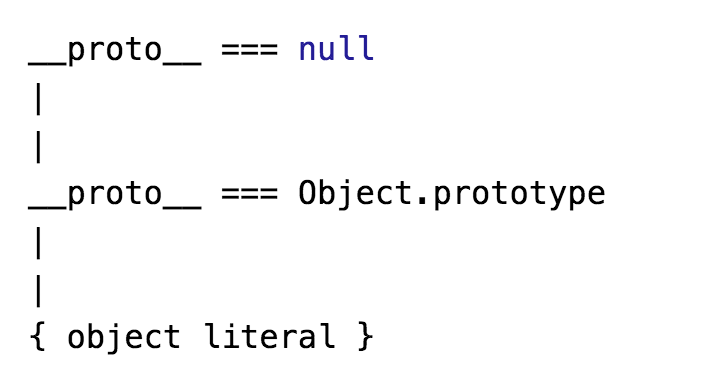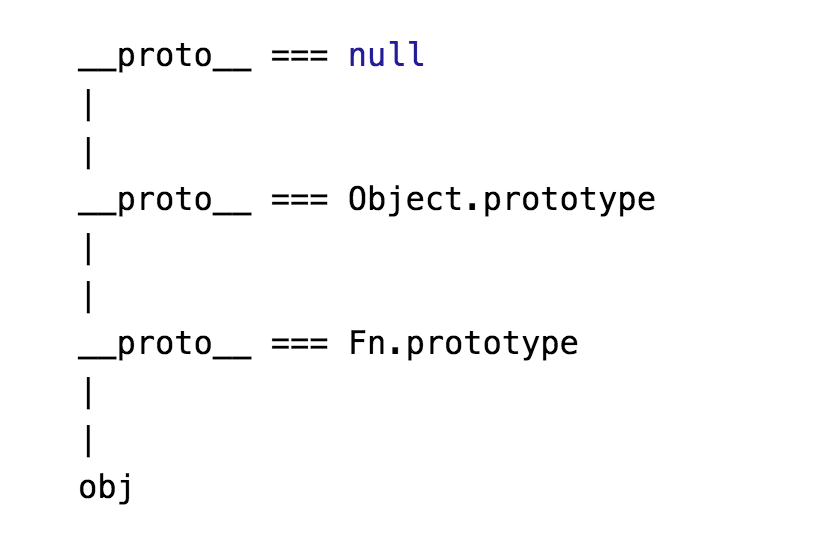如果进入到Javascript 面向对象的领域,那么对象原型Object Prototypes你就一定会接触到,我也是以前看的云里雾里的,总感觉空洞,和实际使用的场景结合不起来,但最近看了一篇文章,感觉清楚多了,所以分享给大家,希望有所帮助吧。
1 什么是对象原型?
对象都有一个原型属性,通过__proto__(称为dunder proto)获得,这个属性强烈不建议直接通过dot符读取或者修改, MDN 里面有特别强调,这个原型属性是一个指针,指向另一个对象
var obj = {};
console.log(obj.__proto__);
// -> {constructor: ƒ, __defineGetter__: ƒ, __defineSetter__: ƒ, hasOwnProperty: ƒ, __lookupGetter__: ƒ, …}对象原型有三点要注意:
1 每个对象都有一个__proto__属性
2 对象字面量的__proto__恒等于Object.prototype
3 Object.prototype的__proto__ 等于null
2 __proto__有什么用?
用于对象属性的查找,Javascript engine查找对象属性的时候,首先查找对象本身,如果没有,会查找对象原型所指向的对象,如果仍然没有找到,会查找原型的原型,直到某个对象的__proto__为null,这就是原型链

var obj = {};
obj.__proto__.testValue = 'Hello!'; // 注意,这里的操作是为了演示,不推荐操作__proto__
console.log(obj); // -> {}
console.log(obj.testValue); // -> Hello!3 有关的方法和属性
obj.hasOwnProperty()
判断某个属性是否是obj自己的
var obj = {};
obj.__proto__.testValue = 'Hello!'; // 注意,这里的操作是为了演示,不推荐操作__proto__
console.log(obj.hasOwnProperty('testValue'));
// -> false
console.log(obj.hasOwnProperty('__proto__'));
// -> false
console.log(obj.__proto__.hasOwnProperty('testValue'));
// -> trueObject.getOwnPropertyNames()
获得对象自己的属性名组成的数组
var obj = { prop: 'Hi there!' };
obj.__proto__.testProp = 'Hello!';
console.log(Object.getOwnPropertyNames(obj)); // -> [ 'prop' ]Object.getPrototypeOf()
获得对象的原型
var obj = {};
console.log(Object.getPrototypeOf(obj) === obj.__proto__);
// -> trueObject.setPrototypeOf()
设置原型对象
var obj = {};
var protoObj = {};
Object.setPrototypeOf(obj, protoObj);
console.log(Object.getPrototypeOf(obj) === protoObj);
// -> true4 原型继承
Javascript中的继承是通过原型完成的...
4.1 Function Prototypes & new
函数的prototype不同于它的__proto__属性,看起来有点绕
functions's prototype's __proto__ === Object.prototype
function fn() {}
var protoOfPrototype = Object.getPrototypeOf(fn.prototype);
// protoOfPrototype === fn.prototype.__proto__
console.log(protoOfPrototype === Object.prototype);
// -> true但我们使用new 调用function 时, Javascript engine会设置this的__proto__ 等于function的prototype,这就是继承的关键
function PersonConstructor(name, age) {
// this = {};
// this.__proto__ = PersonConstructor.prototype;
// Set up logic such that: if
// there is a return statement
// in the function body that
// returns anything EXCEPT an
// object, array, or function:
// return 'this' (the newly
// constructed object)
// instead of that item at
// the return statement;
this.name = name;
this.age = age;
// return this;
}到这里,可以得出三点:
1 使用new 创建的函数对象的__proto__等于该函数的prototype
2 function's prototype's__proto__ 等于Object.prototype
3 Object.prototype's__proto__等于null
function Fn() {}
var obj = new Fn();
var firstProto = Object.getPrototypeOf(obj);
// firstProto === obj.__proto__
console.log(firstProto === Fn.prototype); // -> true
var secondProto = Object.getPrototypeOf(firstProto);
// secondProto === obj.__proto__.__proto__
console.log(secondProto === Object.prototype); // -> true
var thirdProto = Object.getPrototypeOf(secondProto);
// thirdProto === obj.__proto__.__proto__.__proto__
console.log(thirdProto === null); // -> true
注意:区别于1中的对象字面量
4.2 实现继承
我们可以安全地操作function的prototype,比如修改function's prototype的方法或属性,那么通过new 创建的对象就会继承这些方法或属性
function Fn() {}
Fn.prototype.print = function() {
console.log("Calling Fn.prototype's print method");
};
var obj = new Fn();
obj.print(); // -> Calling Fn.prototype's print method如果我们把print方法写在Fn的构造函数里呢?效果是不是一样?
function Fn() {
this.print = function() {
console.log("Calling Fn.prototype's print method");
};
}
var obj = new Fn();
obj.print(); // -> Calling Fn.prototype's print method不同点是:如果print写在构造函数里,那么通过new生成的每个对象都有一份print方法,在内存和性能上和写在原型上是不一样的,写在原型是是所有new出来的对象共用一份print方法
下面是一份对比试验,可以看出创建print方法在prototype上的对象比创建print方法在构造函数中的对象快一倍左右
function FuncOnThis () {
this.print = function () {
console.log('Calling print')
}
}
let arr = []
console.time('FuncOnThis')
for (let i = 0; i < 2000000; i++) {
arr.push(new FuncOnThis())
}
console.timeEnd('FuncOnThis')
// FuncOnThis: 763.890ms
function FuncOnProto () {
}
FuncOnProto.prototype.print = function () {
console.log('Calling print')
}
console.time('FuncOnProto')
let arr2 = []
for (let i = 0; i < 2000000; i++) {
arr2.push(new FuncOnProto())
}
console.timeEnd('FuncOnProto')
// FuncOnProto: 334.594ms
4.3 字面量的__proto__
现在已经知道object's __proto__等于创建该对象的function's prototype, object 字面量来自Object, array 来自 Array, function来自Function
console.log(
Object.getPrototypeOf({}) === Object.prototype
); // -> true
console.log(
Object.getPrototypeOf([]) === Array.prototype
); // -> true
console.log(
Object.getPrototypeOf(function fn() {})
=== Function.prototype
); // -> true4.4 构造函数constructor
function's prototype都有一个constructor属性,这是一个指针,指向函数本身
function Fn() {}
console.log(Fn.prototype.constructor === Fn);
// -> true所以,使用new创建的对象,它的构造函数也指向该函数,沿着原型链向上查找,会找到Fn's prototype’s constructor
function Fn(){}
var obj = new Fn();
console.log(obj.constructor);
// -> [Function: Fn]通过对象的构造函数属性,可以知道该对象是哪个函数创建的
function Fn() {};
var normalObj = {};
var fnObj = new Fn();
console.log(normalObj.constructor); // -> [Function: Object]
console.log(fnObj.constructor); // -> [Function: Fn]4.5 自定义原型创建对象
Object.create(param)
这个函数用于创建对象,接收一个对象作为参数,创建的新对象的__proto__等于传入的参数
var prototypeObj = {
testValue: 'Hello!'
};
var obj = Object.create(prototypeObj);
console.log(obj); // -> {}
console.log(
Object.getPrototypeOf(obj) === prototypeObj
); // -> true
console.log(obj.testValue); // -> 'Hello!'Object.create()提供了一种更灵活的方式去扩展原型链,使得对象不仅继承于function's prototype, 而是任何object
总结:
1 function's prototype 不同于 __proto__
2 functions' prototype's __proto__ 等于Object.prototype
3 Object.prototype's __proto__等于null
4 使用new创建函数对象的__proto__等于该构造函数的prototype
参考资料:
https://www.educative.io/collection/page/5679346740101120/5707702298738688/5665117697998848
https://www.educative.io/collection/page/5679346740101120/5707702298738688/6330230964748288